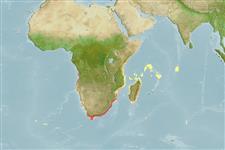Environment: milieu / climate zone / depth range / distribution range
Ecologia
marinhas; estuarina; oceanódromo (Ref. 51243). Tropical
Southeast Atlantic: known only from Mossel Bay and the Kosi Estuary in South Africa. Reported from Angola (Ref. 3468) and Mozambique (Ref. 12484).
Comprimento de primeira maturação / Tamanho / Peso / Idade
Maturity: Lm 38.0 range ? - ? cm
Max length : 75.0 cm TL macho/indeterminado; (Ref. 4393); peso máx. publicado: 3.1 kg (Ref. 4699)
Espinhos dorsais (total) : 5; Raios dorsais (total) : 8; Espinhos anais: 3; Raios anais : 9.
Occur mainly in estuaries, congregating over mud-banks (Ref. 2830). Oviparous, eggs are pelagic and non-adhesive (Ref. 205). Omnivore (Ref. 97629). Fleshy highly esteemed (Ref. 4393).
Ciclo de vida ou comportamento de acasalamento
Maturities | Reprodução | Spawnings | Egg(s) | Fecundities | Larvas
van der Elst, R., 1981. A guide to the common sea fishes of southern Africa. C. Struik, Cape Town. 367 p. (Ref. 3670)
Status na Lista Vermelha da UICN (Ref. 130435)
Ameaça para os humanos
Harmless
Uso pelos humanos
Pescarias: pouco comercial; peixe esportivo: sim
Ferramentas
Relatórios especiais
Baixar XML
Fontes da internet
Estimates based on models
Preferred temperature (Ref.
123201): 18.5 - 26.3, mean 24.9 °C (based on 34 cells).
Índice de diversidade filogenética (Ref.
82804): PD
50 = 0.5005 [Uniqueness, from 0.5 = low to 2.0 = high].
Bayesian length-weight: a=0.01445 (0.00822 - 0.02541), b=2.96 (2.81 - 3.11), in cm total length, based on LWR estimates for this species & Genus-body shape (Ref.
93245).
Nível Trófico (Ref.
69278): 2.5 ±0.16 se; based on food items.
Resiliência (Ref.
120179): Baixo, tempo mínimo de duplicação da população 4,5 - 14 anos (Preliminary K or Fecundity.).
Fishing Vulnerability (Ref.
59153): Moderate to high vulnerability (50 of 100).
